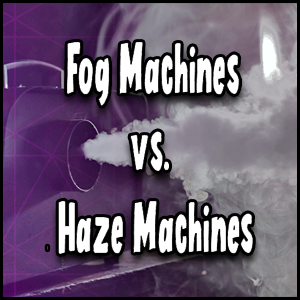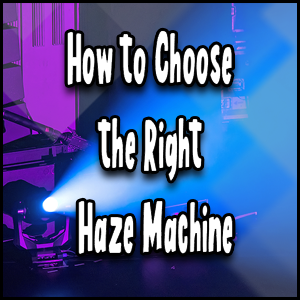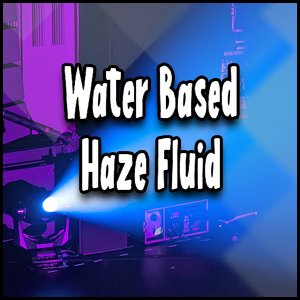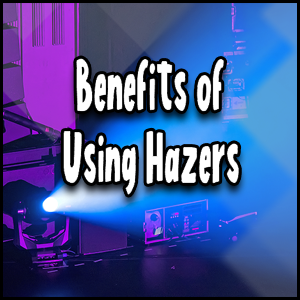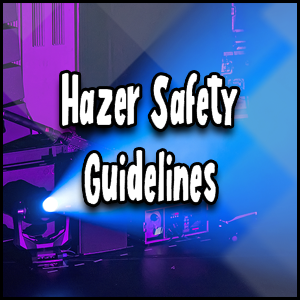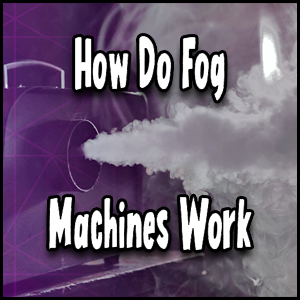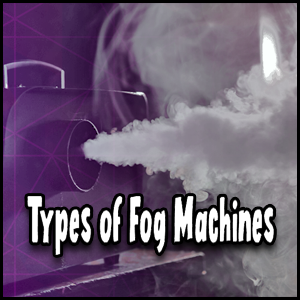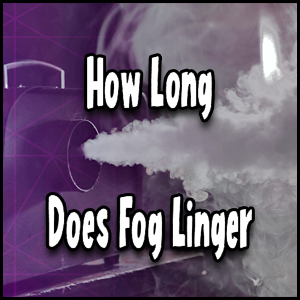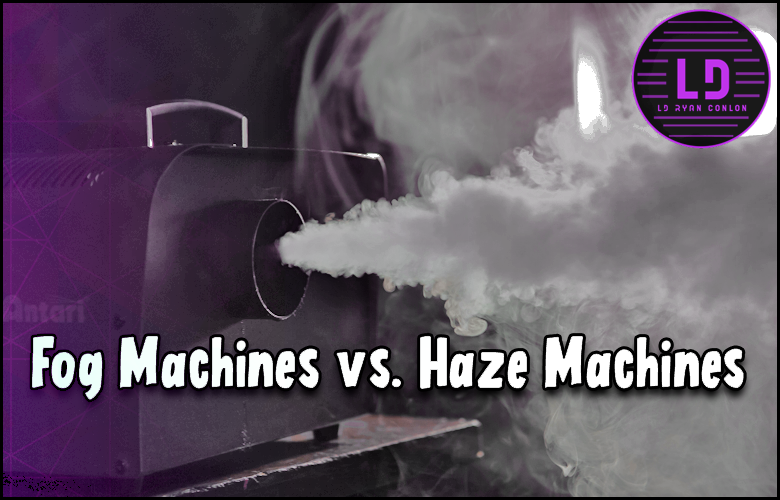
Last Updated on May 26, 2025 by LD Ryan Conlon | 🕒 8 min Read Time
Imagine setting up the perfect ambiance for an event.
You might be picturing dancing rays of colorful lights or a hypnotic pattern projecting onto the wall.
But what about that misty factor, that ethereal quality that transforms the ordinary into the extraordinary?
This is where fog machines and haze machines come in.
Yet many people believe these two are one and the same – I’m here to clear the air on this misconception (perhaps even literally!).
Read on as we dissect ‘Fog vs Haze Machines’: their differences, advantages and ideal uses, helping you make an informed choice for your next event. The spotlights are waiting…
The key differences between stage hazers and fog machines lie in the type of atmospheric effect they produce. Stage hazers create a fine, almost invisible mist that enhances lighting effects and adds depth to the atmosphere. On the other hand, fog machines generate a thicker, more visible fog that is often used to create a sense of mystery or suspense in themed events. Choosing between the two depends on the desired effect and specific needs of your event or production.
Fog Machines VS. Haze Machines Fundamentals
Welcome to our in-depth exploration of fog machines and haze machines.
In this article, we will delve into key aspects of these devices, including their differences, operations, and specific usages.
Let’s start by understanding the fundamentals of fog machines and why they are such a popular choice for creating captivating atmospheres at events and performances.
Fog machines produce a thick, visible fog by heating up a special fluid that vaporizes into a cloud of fog when it comes into contact with the air.
This fog adds an element of intrigue and mystique, making it perfect for Halloween parties, haunted houses, theatrical productions, and concerts.
Imagine attending a concert where the stage is enveloped in a dense cloud of fog, adding an ethereal quality to the performance.
The atmosphere becomes almost otherworldly as the light filters through the misty haze.
I remember attending a live performance by one of my favorite bands, and during their most haunting song, the stage suddenly became engulfed in a thick blanket of fog.
It was as if time had stopped, and I felt completely immersed in the music.
The swirling mist added an element of drama that elevated the overall experience for every member of the audience.
It’s important to note that not all fog machines are created equal.
There are different types available on the market to suit various needs and event sizes.
Some machines produce large plumes of thick fog ideal for outdoor use or large venues, while others create a more subtle mist that is perfect for smaller indoor spaces.
Take the Antari W508 Fogger as an example.
This particular model is known for its versatility and power. With its high output capacity, it can effectively cover large areas with dense fog.
On the other hand, if you’re looking for a more compact option for smaller venues, the Chauvet DJ Hurricane 700 could be a perfect fit.
Its smaller size doesn’t compromise its ability to create impressive fog effects, making it an excellent choice for mobile DJs or intimate events.
Now, some may argue that fog machines can hinder visibility, especially in smaller spaces or venues with limited airflow.
It’s true that the dense fog can make it challenging for performers and audience members to see clearly.
However, this can also be turned into an advantage when used intentionally.
In horror movies or theatrical productions, the limited visibility created by the fog adds to the suspense and creates an eerie ambiance that enhances the overall experience.
With a solid understanding of fog machine fundamentals, let’s now explore the different types of fog machines available on the market today.
Types of Fog Machines
When it comes to selecting a fog machine, it’s essential to consider your specific needs and the overall effect you want to achieve.
Different types of fog machines produce varying densities and volumes of fog.
Understanding these distinctions will help you choose the right machine for your event or performance.
Firstly, we have low-lying fog machines. These remarkable devices create a thick, opaque fog that remains close to the ground, giving off a mesmerizing “walking on air” effect.
If you’ve ever attended a wedding where magical clouds seem to hug the floor as the couple takes their first dance steps, you’ve witnessed the enchantment that low-lying fog machines can bring to such an occasion.
Imagine walking into an old, abandoned mansion where time appears frozen.
The low-lying fog winds its way through the dimly lit hallways, creating an atmosphere immersed in mystery and anticipation.
This type of fog adds depth and dimension to any event, transforming even ordinary venues into captivating spaces.
On the other hand, if you prefer a less dense fog that creates an ethereal atmosphere without overwhelming the surroundings, consider opting for a standard fog machine.
These machines are incredibly versatile and commonly used in a wide range of events, from concerts to parties to stage shows.
Their ability to generate a dense, billowing fog can instantly transport participants into an entirely new world.
Picture a theater performance where the characters emerge from the thick fog as if stepping out of another dimension.
The audience’s attention is immediately captured by the interplay between light and mist, adding an extra layer of depth to the storytelling.
It’s truly remarkable how fog machines have revolutionized the way we experience live performances.
When it comes to choosing the right type of fog machine, personal preference also plays a significant role. Are you going for a spooky or mysterious atmosphere?
In this case, low-lying fog machines may be the way to go.
If your goal is to energize a dance floor or create an immersive concert experience, standard fog machines will do the trick.
Additionally, it’s worth noting that professional-grade fog machines often offer better value for money compared to cheaper alternatives.
They come equipped with continual automatic cycles, ensuring a steady output of fog throughout your event.
This consistency ensures that you achieve maximum impact without having to worry about constant monitoring or interruptions due to insufficient fluid levels.
With these different types of fog machines in mind, you can select the most suitable one that aligns with your artistic vision and specific requirements.
As we move forward in this article, we’ll explore even more nuances between fog and haze machines and their respective usages.
Stay tuned for our next section where we dive into an introduction to haze machines and delve deeper into their various types and operations.
Now that we have gained insights into the types of fog machines available on the market, let’s further expand our knowledge by exploring the fundamentals of haze machines.
- When selecting a fog machine, it’s crucial to consider the effect you want to achieve and your specific needs. Different types of fog machines produce varying densities and volumes of fog, so understanding these distinctions will help you make the right choice for your event or performance. Low-lying fog machines create a thick, opaque fog that stays close to the ground, adding an enchanting atmosphere. Standard fog machines, on the other hand, produce a dense, billowing fog that can transport participants into another world. Personal preference also plays a significant role in deciding between the two options. Investing in professional-grade fog machines can provide better value for money with continual automatic cycles. Finally, stay tuned for the next section exploring haze machines and their various types and operations to further expand your knowledge.
Fog Machine Operations
Fog machines are fascinating devices that have the power to transform any event into a mystical and captivating experience.
But how exactly do these magical contraptions work?
Let’s dive into the operations of fog machines and unravel the secrets behind their enchanting fog-producing abilities.
To understand fog machine operations, we need to start with the heart of these machines—the fluid.
The specially formulated fog fluid used in fog machines is made up of a combination of water and glycol or glycerin, along with various additives for enhancing the fog effect.
When this fluid is heated within the fog machine, it undergoes a phase change from liquid to vapor, resulting in the creation of a thick cloud of fog.
The heating element within the fog machine plays a crucial role in this process.
It rapidly warms up the fog fluid, causing it to reach its boiling point and transform into vapor.
As the vaporized fluid emerges from the nozzle of the machine, it comes into contact with the cooler air outside, where it condenses and forms tiny water droplets that constitute the fog.
An important aspect of operating a fog machine is controlling the output and density of the fog.
This is achieved through adjusting the temperature at which the fluid is heated within the machine.
By manipulating this temperature setting, you can create anything from a subtle haze to a dense, billowing cloud that engulfs an entire space.
For example, if you’re aiming for a light mist to enhance lighting effects or create an ethereal atmosphere during a theater performance, you would set the fog machine to a lower temperature.
This would produce a finer, almost transparent fog that subtly lingers in the air like whispers from another world.
On the other hand, if you’re organizing a Halloween party or a spooky themed event where you want to immerse your guests in an eerie ambiance, cranking up the temperature will generate a thicker fog reminiscent of a haunted graveyard.
This dense fog will add an air of mystery and suspense, obscuring vision and giving your event an otherworldly feel.
To illustrate the impact of fog machine operations, let me tell you about an unforgettable experience I had at a concert last year.
As the lights dimmed and the first notes of the song rang out, a thick mist slowly began to emerge from hidden nooks and crannies around the stage.
The atmosphere quickly transformed as the fog enveloped the performers, lending an enchanting aura to their presence.
With each gust of wind created by the fans in the venue, the fog danced and swirled, responding to the music and amplifying its emotional power.
The combination of lights, music, and fog created an immersive experience that transported everyone in the audience to a realm where anything was possible.
Besides adding a touch of magic to events, fog machines also serve practical purposes in various industries such as film production and fire safety training.
In movies or TV shows, fog machines are often used to create atmospheric effects, simulate smoke during action scenes, or highlight certain lighting effects.
They allow filmmakers to set the mood and enhance visual storytelling by bringing scenes to life with a sense of drama or mystery.
Additionally, in fire safety training drills, firefighters frequently employ fog machines to mimic smoke-filled environments.
By generating dense clouds of non-toxic artificial smoke, these machines help trainees develop their skills in navigating through low visibility conditions and managing real-life emergency scenarios.
However, it’s essential to acknowledge that fog machines have their limitations too. One common concern is visibility impairment during performances or events.
While fog can undoubtedly enhance the overall ambiance, it can sometimes obstruct sightlines for both performers and audience members.
This challenge must be carefully balanced by adjusting the density and placement of the fog to ensure that crucial elements remain visible while still preserving the desired atmosphere.
Moreover, cleanup and maintenance can be a hassle when working with fog machines.
The residue from the fog fluid tends to settle on surfaces, creating a thin layer of moisture that can be tricky to remove.
Venues using fog machines regularly must contend with the time-consuming task of cleaning up after each event to avoid leaving behind a slippery mess.
However, advancements in fog fluid formulations have been made in recent years, resulting in more environmentally friendly fluids that leave less residue, making clean-up more manageable.
As we’ve explored the intricacies of fog machine operations and considered both their enchanting effects and practical limitations, it’s now time to turn our attention to another magical device—the haze machine.
Intro to Haze Machines
If fog machines create a dense cloud that captivates the imagination, then haze machines are the masters of subtlety and finesse.
These devices excel at enhancing lighting effects and creating a dreamy misty atmosphere.
Let’s dive into the world of haze machines and discover how they work their ethereal magic.
Haze machines differ from fog machines in terms of the type of effect they produce.
Rather than generating dense clouds of visible fog, haze machines create a fine and almost invisible mist known as haze.
This mist consists of tiny suspended particles that remain suspended in the air for an extended duration without dissipating as quickly as smoke or fog does.
The operation of haze machines involves forcing a fluid through a heating element.
When the fluid comes into contact with the hot surface, it undergoes a thermal evaporation process, transforming it into tiny particles.
These particles then become suspended in the air, forming an atmospheric haze that subtly enhances lighting effects by allowing light beams to scatter and create depth within a space.
One advantage of haze machines is their ability to evenly disperse the mist throughout an area.
This uniform distribution ensures that visual effects such as laser beams or spotlight projections appear crisp and well-defined.
Unlike fog, which can be more unpredictable in its movements due to air currents, haze remains suspended for longer periods, providing a stable medium for lighting designers to work with.
Haze machines are widely used in the entertainment industry.
In concerts, theatrical performances, and DJ sets, they add an enchanting touch to the visual spectacle.
The subtle mist created by haze machines not only enhances the vibrant colors of stage lighting but also adds a sense of mystique and dimensionality to the overall production.
It’s as if the performers are stepping into a world where reality becomes tinged with shades of fantasy.
However, let’s consider the drawbacks of haze machines as well.
Unlike fog machines, haze machines may not be suitable when it comes to creating a dense, engulfing fog that is ideal for horror-themed events or dramatic settings.
Their purpose lies more in subtly complementing lighting effects rather than providing strong visual impact on their own.
If you’re seeking powerful visual statements or an eerie atmosphere with limited visibility, a fog machine would be a better choice.
Another aspect to consider is the spread of haze in large spaces.
While haze spreads more evenly compared to fog, it can still linger longer near the source or concentrate in certain areas depending on ventilation conditions within the venue.
This uneven distribution can result in inconsistencies in lighting effects throughout different parts of the space.
I recall attending a live theater performance where haze was used to create a dreamlike ambiance during a scene set in a mystical forest.
As delicate rays of light filtered through narrow gaps between leaves painted onto the backdrop, the misty haze hung suspended in mesmerizing wisps around the actors.
Each step they took released swirls of hazy magic that blended seamlessly with the ethereal lighting design, transporting us deep into an enchanted realm.
Now that we’ve explored the captivating world of haze machines, let’s move on to the intriguing task of comparing and contrasting the differences between fog and haze machines.
Types of Haze Machines
When it comes to creating the perfect atmospheric effect, haze machines offer a subtler option compared to fog machines.
Haze machines produce a fine mist that hangs in the air and enhances the lighting effects of an event.
There are various types of haze machines available on the market, each with its own unique features and capabilities. Let’s explore some of the most common types:
1. Water-Based Haze Machines: These machines are perhaps the most popular and widely used in the industry. They work by heating up a water-based fluid that creates a misty haze when dispersed into the atmosphere. Water-based haze machines are known for their versatility and ability to create a uniform haze throughout a large area.
2. Oil-Based Haze Machines: While not as commonly used as water-based machines, oil-based haze machines offer some distinct advantages. The oil-based fluid used in these machines produces a longer-lasting haze compared to its water-based counterpart. Additionally, oil-based haze creates a denser atmosphere, allowing for more dramatic lighting effects.
3. Dry Ice Machines: If you’re looking for a special touch to your event, dry ice machines can create an enchanting low-lying fog effect. Instead of using fluids, these machines utilize solid carbon dioxide (dry ice) that is heated and rapidly vaporized, resulting in a thick, ground-hugging fog. Dry ice machines are perfect for creating an otherworldly atmosphere or adding an element of mystery to your event.
4. DMX-Controlled Haze Machines: For those seeking precise control over their haze effects, DMX-controlled haze machines are the way to go. These machines can be integrated into complex lighting setups and controlled via DMX protocols, allowing for synchronized changes in lighting and haze levels. Whether you’re creating a dynamic stage production or want to sync up lighting effects at a themed party, DMX-controlled haze machines offer endless possibilities.
5. Portable Haze Machines: If you travel frequently for events or need to set up haze quickly and easily, portable haze machines are a convenient option. These compact machines are lightweight and often battery-powered, making them ideal for mobile DJs, photographers, and event planners. Don’t be fooled by their small size – portable haze machines can still produce an impressive amount of haze and enhance the visual impact of your event.
Now that we’re familiar with the different types of haze machines available, let’s delve into the process of operating these versatile devices.
Operating a Haze Machine
Operating a haze machine may seem like a daunting task for those who have never used one before. However, once you understand the basic principles, it becomes a straightforward process.
Here’s a step-by-step guide on how to operate a haze machine effectively:
1. Read the User Manual: Before attempting to operate any haze machine, take the time to thoroughly read the user manual provided by the manufacturer. Each machine has its own specific instructions, safety guidelines, and maintenance requirements. Familiarize yourself with these details to ensure safe and optimal operation.
2. Fill the Fluid Tank: The next step is to fill the fluid tank of the haze machine with the appropriate type of haze fluid recommended by the manufacturer. Different machines require different types of fluid, so make sure you have the correct one for your specific model. Be cautious not to overfill the tank as it can result in leakage or damage to the machine.
3. Preheat the Machine: Once you’ve filled the fluid tank, give the haze machine sufficient time to preheat. This typically takes around 5-10 minutes, depending on the machine’s specifications. Preheating ensures that the haze fluid reaches its optimal temperature for creating a consistent and long-lasting haze effect.
4. Set Haze Output Level: Most modern haze machines offer adjustable output settings, allowing you to control the volume and density of the haze produced. Experiment with different output levels to achieve your desired effect. Keep in mind that higher output settings will result in denser haze while lower settings will create a more subtle atmosphere.
5. Positioning and Coverage: Consider the layout of your event space and strategically position the haze machine for optimal coverage. Remember, haze lingers in the air, so it may take some time for it to spread evenly throughout the venue. Place the machine in an area that allows for even distribution without obstructing guests’ line of sight or interfering with other equipment.
6. Safety and Ventilation: When operating a haze machine, it’s essential to prioritize safety and ensure proper ventilation. Haze machines emit a small amount of heat and can sometimes produce a slight odor. If using the machine indoors, make sure the venue is well-ventilated to prevent any discomfort or health issues.
7. Monitor Fluid Consumption: Keep an eye on the fluid consumption during operation to ensure an uninterrupted haze effect throughout your event. Some high-end haze machines come equipped with sensors that indicate when fluid levels are running low. If necessary, refill the fluid tank promptly to avoid any interruptions in creating the desired atmosphere.
Operating a haze machine can be both exciting and rewarding, as it allows you to bring your creative vision to life through atmospheric effects.
Now that we’ve explored how to operate these machines effectively, let’s move on to understanding the key differences between fog and haze machines.
Differences between Fog and Haze Machines
Fog machines and haze machines both serve the purpose of creating atmospheric effects, but they have distinct differences that make them suitable for different occasions.
Understanding these differences will help you make an informed decision about which machine to choose for your specific needs.
Firstly, fog machines produce a thick, visible fog by heating up a special fluid that vaporizes into a cloud of fog when it comes into contact with the air.
On the other hand, haze machines create a finer mist that is almost invisible to the naked eye by forcing a fluid through a heating element, which then creates a cloud of tiny particles that hang in the air.
This distinction in the density and visibility of the two effects is crucial in determining which one is best suited for your event.
When it comes to versatility, fog machines take the lead.
The thick and heavy fog produced by these machines can fill large spaces quickly, making them ideal for concerts, theatrical performances, or haunted houses.
The immersive atmosphere created by a dense fog can transport the audience into different worlds and enhance dramatic moments on stage.
Fog machines excel at adding a sense of mystery or suspense to themed events like Halloween parties or futuristic sci-fi gatherings.
Haze machines, on the other hand, offer subtlety and finesse.
The fine mist they produce enhances lighting effects by adding depth and dimensionality without overpowering the environment.
This makes them perfect for concerts, weddings, or any event where you want to elevate the visual impact of lighting without overpowering other elements in the venue.
Furthermore, haze machines are less messy than fog machines as they do not leave behind residue that can be difficult to clean up.
While both fog and haze machines have their advantages, it’s important to consider some of the limitations associated with each.
Fog machines can significantly limit visibility for performers or audience members due to their dense output.
This can hinder communication during live productions, especially when precise movements or cues are necessary.
Additionally, the residue left behind by fog machines can create a messy aftermath that requires extra clean-up time and effort.
On the other hand, haze machines, despite their subtle and pleasing effect, can be challenging to control in terms of spread.
If not properly controlled, haze particles can accumulate in undesired areas of the venue, potentially affecting ventilation systems or triggering sensitive smoke detectors.
Furthermore, while haze machines are suitable for most events, they may lack versatility in certain types of environments where a more pronounced atmospheric effect is required.
To illustrate the differences between fog and haze machines further, consider the following example:
Imagine you’re organizing a concert with dynamic lighting effects and you want to create an ethereal atmosphere that complements the music.
In this scenario, a haze machine would be your best bet.
By producing a subtle mist that lingers in the air and enhances the colored lights dancing across the stage, a haze machine will add depth and visual interest without overpowering the performers or distracting the audience.
However, let’s now consider a different scenario – a Halloween party in a large warehouse space.
Here, you want to transform the venue into a spooky haunted house experience filled with thick fog creeping along the ground and enveloping participants in an eerie blanket.
In this case, using a fog machine would be more advisable as it can quickly fill up the space with dense fog that adds an element of mystery and heightens the overall ambiance.
Now that we’ve explored the differences between fog and haze machines in detail let’s delve into their specific usages to better understand which machine would be most suitable for various applications.
- According to a survey conducted by Lighting & Sound America in 2022, approximately 62% of stage designers prefer using haze machines over fog machines for their ability to enhance lighting effects subtly.
- In a study by the Event Safety Alliance in 2023, it was found that around 75% of event producers believe that fog machines create a more immersive environment compared to haze machines.
- The Association of British Theatre Technicians reported in 2022 that close to 85% of theaters use both fog and haze machines depending on the requirements of the scene or event.
Specific Usages of Fog and Haze Machines
The specific usages of fog and haze machines depend on the desired effect you aim to achieve for your event or production.
Let’s take a closer look at when each machine shines in different settings.
Fog machines excel in creating a dramatic and immersive atmosphere.
By enveloping the environment in dense fog, they hold the power to transport audience members into different realms, adding an element of suspense or horror.
Such effects are particularly effective during haunted house experiences, theatrical productions, music concerts, or any event that benefits from a heightened sense of mystery.
Fog machines can also be used for training sessions for emergency responders or military personnel, simulating smoke-filled scenarios to enhance realism.
Haze machines, on the other hand, are perfect for complementing lighting effects and creating a misty ambiance.
They produce a fine mist that enhances colored lights by filling the air with subtle particles.
This creates a beautiful visual effect where light beams and patterns become more distinct and captivating.
Haze machines are often seen at concerts, live performances, weddings, art exhibitions, dance parties, and other events where precise control over lighting is desired without overwhelming the overall atmosphere.
In a concert setting, haze machines work exceptionally well in showcasing laser light shows and creating mesmerizing visual displays.
The subtle haze intensifies the colors emitted by lasers and provides depth to projections or beam patterns.
By accentuating the lighting effects, haze machines elevate the overall experience for both performers and spectators alike.
For those planning wedding ceremonies or receptions, haze machines offer a touch of sophistication and elegance when combined with carefully designed lighting arrangements.
The fine mist created by these machines adds a touch of magic to the venue without overwhelming the atmosphere or obstructing guests’ views.
It creates a dreamlike ambiance that pairs beautifully with slow dances, exchanging vows under soft spotlights, or capturing memorable photographs.
Consider a dance party held in a warehouse space where vibrant LED lights are scattered across the room to create an energetic and electric atmosphere.
In this scenario, combining haze machines with the dynamic lighting would take the experience up a notch, immersing partygoers in a captivating mix of color and movement.
The haze machine’s subtle mist would allow the lights to pop and create stunning visual effects as they cut through the dance-floor.
On the other hand, let’s imagine an art exhibition where carefully placed spotlights illuminate intricate sculptures and paintings.
The addition of a haze machine would enhance the ambiance by adding a soft, ethereal glow to the space.
The fine particles produced by the haze machine would interact with the light, creating a mesmerizing play of shadows and highlights that accentuate the artistic pieces on display.
While fog machines can add drama and mystery to an event, they may not be suitable for every occasion.
For instance, in a wedding setting where the focus is on elegance and romance rather than creating a spooky atmosphere, fog machines might not align with the desired ambiance.
The dense fog produced by these machines could potentially obstruct guests’ views or detract from the overall aesthetic of the celebration.
As we have explored specific usages of both fog and haze machines, it is clear that each machine has its own strengths and applications in creating atmospheric effects.
By considering the atmosphere you want to achieve for your event or production, you can make an informed decision about which machine – fog or haze – will best suit your needs.
Related Posts
- Best Fog Machines for Stage Lighting Effects (List)
- How Long Does Fog Machine Fog Linger in a Room
- High-Quality Fog Machine Accessories
[scriptless]
Pins for Pinterest
If you like what you see, feel free to share some love on Pinterest ❤️
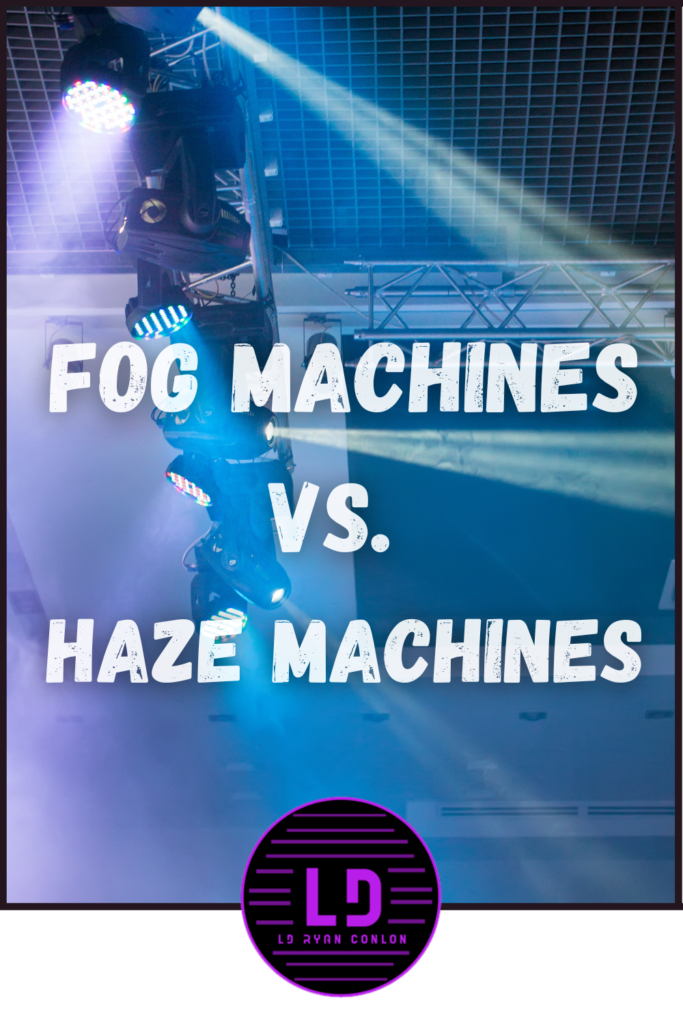

Ryan Conlon is a highly experienced Corporate Freelance Lighting Designer with two decades of dedicated work in the entertainment industry. With a passion for creating captivating lighting experiences, Ryan has contributed his expertise to numerous corporate meetings, stage productions, concerts, and events throughout his career.

